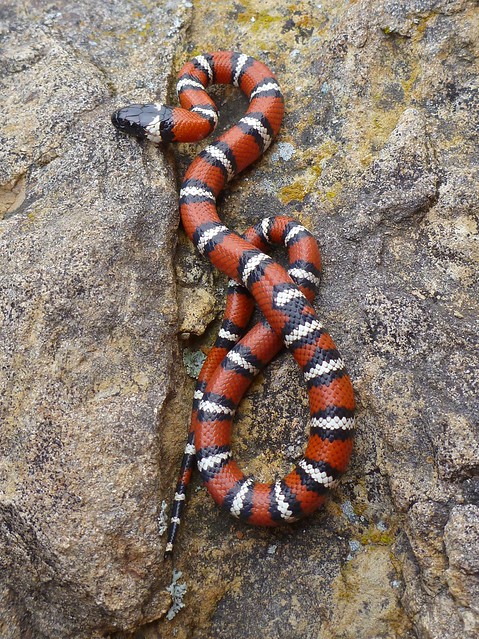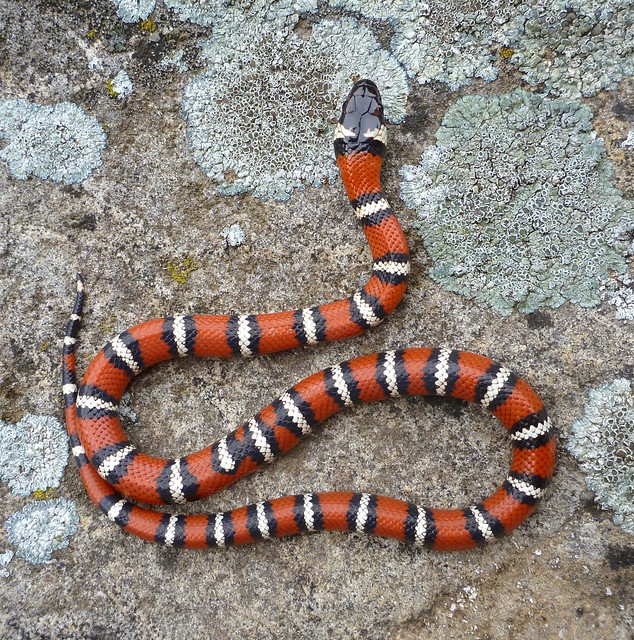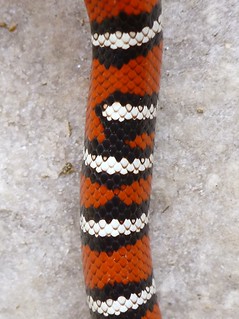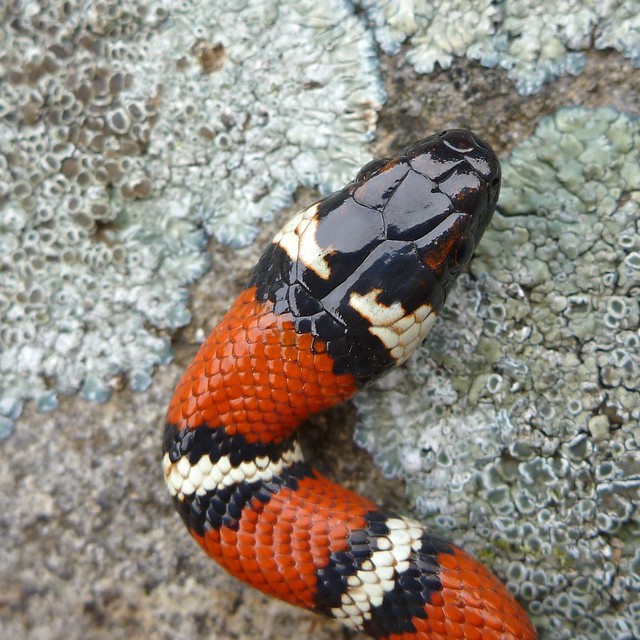It included a cool photo, but I didn't really need one to know what it was.
The sender, Cindy at the Dipper Ranch, is a trusted source. And would never cry wolf. Unless there was one, of course.
So I drove up the next morning as the fog started to break on the 2,000-foot Skyline Ridge, and after a chat and hand-off, found a few native-looking corners on the Dipper to photograph the stunning jewel that Cindy had so graciously held overnight for me.
Lampropeltis zonata multifasciata - a Coast Mountain Kingsnake.
A species I've often looked for in the Santa Cruz Mountains, but not yet found.
And while it wasn't my field find, I was still happy to hang with a truly wild one and get some glam shots before she was returned to her home.
Because, as you can see, she was quite the photogenic poser.



I say "she" because I'm pretty sure it was a female. I couldn't feel or pop any hemipenes, and the tail taper and length was smooth and short.
So, not a Coast Mountain King, but a Coast Mountain Queen.
How very Game of Thrones.
As for age, her total length was only 11.5" inches (30cm), so I'd bet she was born last summer.

She has 29 or 30 triads (I can't remember how to count the head and tail), as well as an excellent beauty mark where the 11th-13th triads have merged together.
Both are features that don't change in life, even as she gets bigger and sheds, so can be used to identify her, or any other individuals, that are caught again.


Facial markings can also be distinctive. In this case, hers are pretty typical, with just a hint of red on the top of her head.



As I tried to get artsy, and create a fun "C is for Cindy" shot, the Mountain Queen decided to show me one of her other talents, and casually slithered straight down the post.
She did it by using the splits in the wood - carefully shaping and wedging sections of her body into them as she moved. Nifty trick, and a good adaptation for an animal that lives and hunts among the cracks and crevices of rocky outcrops.
One thing is for sure - my fun encounter and photo foray proves that old adage: it's always good to have friends in high places.
Especially friendly Coast Mountain Queens.
====
References:
- Dipper Ranch - Scales on my Sleeve
- Dipper Ranch - First Wolf - Yellowstone Reflections
- California Herps - Lampropeltis zonata multifasciata
- Wikipedia - Lampropeltis zonata
- Wikipedia - Hemipenis
- Wikipedia - Game of Thrones



How very very kool is that experience. Thanks for sharing.
ReplyDeleteWow. Those are SUCH amazing photographs, you CLEARLY have snake charming skill.
ReplyDeleteAnd is it me, or is she SO SUPER EXTRA GORGEOUS?!? Jeepers. Total knockout.
I'm thinking she wanted to be the cedilla under the C for Cindy, so folks would know it is a soft C. =)
What a stunning snake. Coast Mountain Kingsnakes were the supreme find of my herping youth. I never found one as attractive as your snake.
ReplyDeleteThey were relatively common at the top of the higher ridges above my home in Carpinteria. If we left at the crack of dawn and hiked uphill all day, we could reach their prime habitat and be back just after dark. We found mountain kingsnakes more often than not.
It was a physical ordeal that I could never hope to repeat.
[swoons] Beautiful snake, great photos. Thank you -- and Cindy -- for sharing this treasure!
ReplyDeleteWhat a find. I never saw a Mountain King (or Queen for that matter!) in all my time in California. I think I recall the Codger catching one in the Santa Cruz Mountains.
ReplyDeleteD
Soon, snakes of all kinds will be knocking at your door for their own glamour shots. She was an amazingly calm and shiny snake in the hand. The next evening I returned her to original found location after I finished mowing the barbed goatgrass that brought me there, and I watched her for 1/2 hour as she poked around the grassland. Your copy of Stubbs: "The combination of a red ring, bordered on either side by a black ring forms a triad . . . Triads are always counted from the back of the head to the vent . . . The tail rings are not included in the total number of triads." I'm still wondering where the rocks are for these beauties I've found on the Dipper Ranch but super glad of evidence that they are breeding.
ReplyDelete
ReplyDeleteWhat a beauty and surprisingly small! I love her unique merged markings. So, based on Cindy's quote of a triad, does she have 30? Very cool. Did you and Cindy know each other before blogging?
Yes, I think 30 is the number of the counting. Cindy and I crossed paths in the blogosphere, but met via Santa Clara Valley CNPS and then had the "oh - you're..." moments.
DeleteThat is a beaut!
ReplyDeleteSome very nice in situ shots."Stare" is my favorite.
ReplyDeleteShared this post with a visitor today who asked if there were any CA mtn kingsnakes in Midpeninsula Regional Open Space preserves. His response: "tinged with envy, but mostly inspiration." Amazed once again at this kingsnake's demonstration of its clinging ability.
ReplyDelete